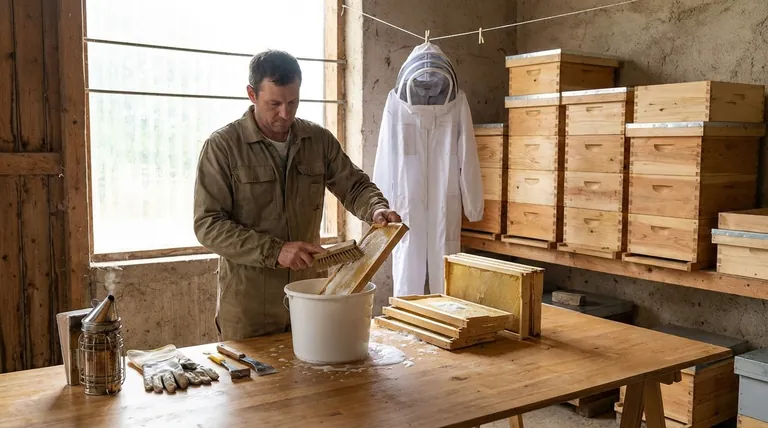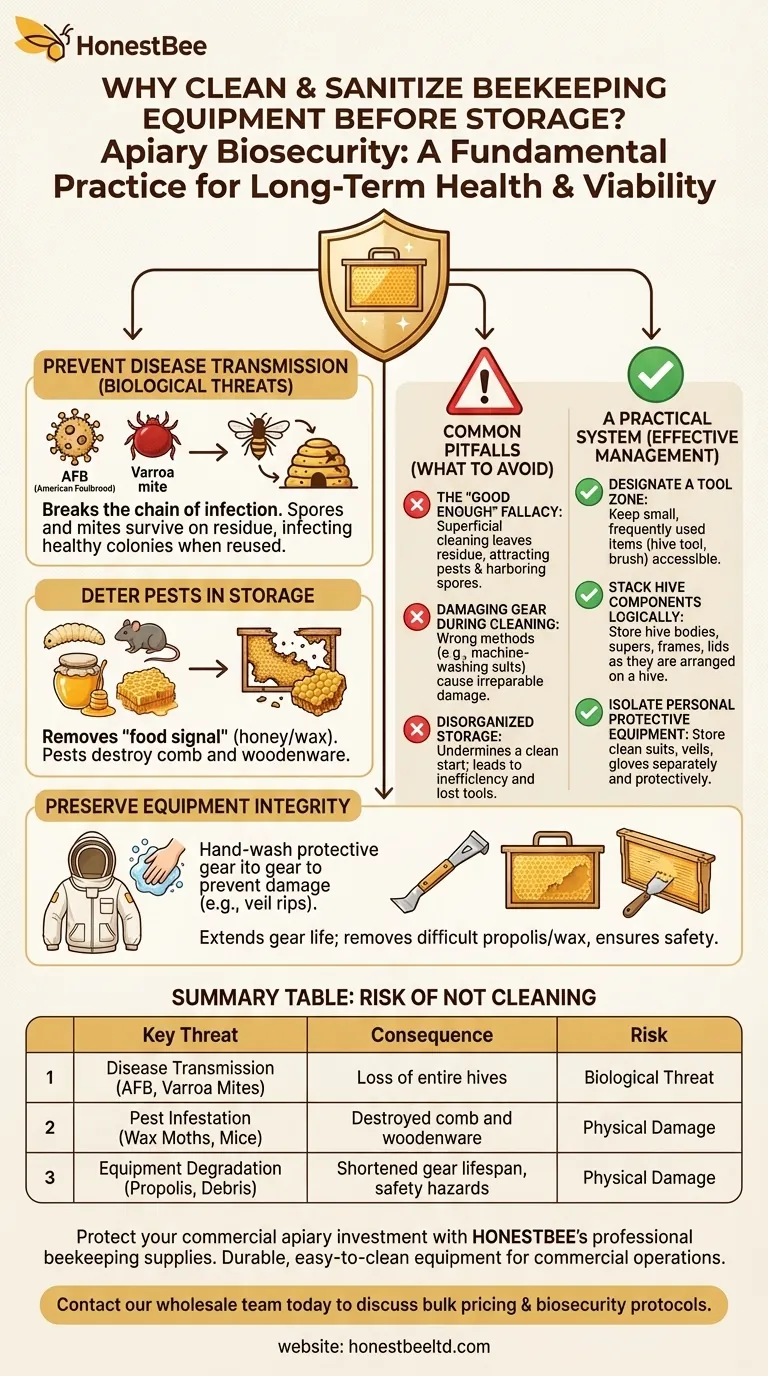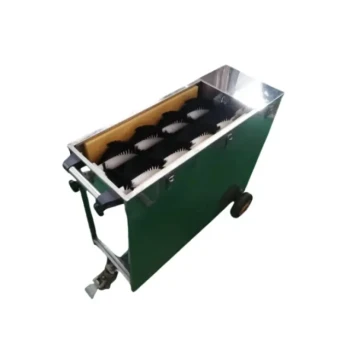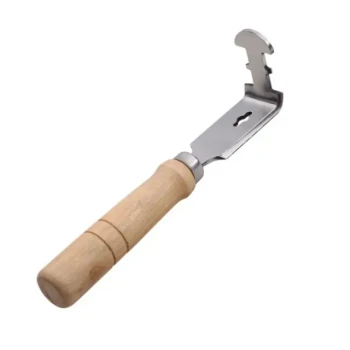At its core, cleaning and sanitizing your beekeeping equipment before storage is a fundamental practice of apiary biosecurity. This process is essential for preventing the spread of devastating diseases and parasites between your hives and protecting your valuable equipment from being destroyed by pests while it is stored.
The discipline of cleaning equipment before storage is not just about tidiness; it is a critical investment in the future health of your bees and the long-term viability of your entire operation.

The Core Risks of Uncleaned Equipment
Failing to properly clean and store your gear introduces significant and unnecessary risks to your bees and your investment. These risks fall into two main categories: biological threats and physical damage.
Preventing Disease Transmission
The most critical reason for sanitation is to break the chain of infection. Spores from diseases like American Foulbrood (AFB) or parasites like Varroa mites can easily survive on leftover wax, propolis, and honey.
When you reuse this contaminated equipment on a healthy colony, you are directly introducing the pathogen, potentially leading to the loss of the entire hive.
Deterring Pests in Storage
Leftover honey and beeswax are powerful attractants for pests. Pests like wax moths and mice can quickly infest your storage area if they detect these residues.
These pests will tunnel through and destroy beeswax comb, chew through wooden frames, and create a mess that renders your equipment unusable. Proper cleaning removes the "food signal" that draws them in.
Preserving Equipment Integrity
Regular cleaning also extends the life of your gear. Caked-on propolis and wax can make hive components difficult to separate and handle, while mud and debris on footwear can compromise your safety.
For personal gear like your beekeeping suit, hand-washing prevents damage to the delicate veil and ensures the suit remains effective for future use.
Understanding the Common Pitfalls
While the benefits are clear, beekeepers often make mistakes that undermine their efforts. Avoiding these common pitfalls is key to an effective equipment management strategy.
The "Good Enough" Fallacy
It can be tempting to do a quick scrape and put equipment away at the end of a long season. This is a false economy.
A superficial cleaning often leaves behind enough residue to attract pests and harbor disease spores, completely negating the effort. Thoroughness is non-negotiable.
Damaging Gear During Cleaning
The goal is to preserve equipment, not destroy it. For example, machine-washing a bee suit can rip the veil, making it useless.
Always use the appropriate cleaning method for the item. Gentle hand-washing for clothing and proper scraping for woodenware ensures you aren't causing more harm than good.
Disorganized Storage Undermines a Clean Start
Simply having clean equipment is only half the battle. Storing it in a disorganized pile creates problems for the next season.
Failing to stack hive components logically or keep small tools together leads to inefficiency and frustration when you need to quickly assemble a hive or find your hive tool.
A Practical System for Equipment Management
An effective system makes the process routine and efficient. It involves organizing your gear for cleaning, use, and storage.
Designate a Tool Zone
Keep small, frequently used items like your hive tool and bee brush in one specific, easily accessible place. This prevents you from misplacing them and ensures they are ready when you need them.
Stack Hive Components Logically
Store your hive bodies, supers, frames, and lids by stacking them just as they would be arranged on a hive. This method is space-efficient, keeps components together, and makes assembling a new hive simple and fast.
Isolate Personal Protective Equipment
Your bee suit, veil, and gloves should be kept together, separate from the hive components. After washing and thoroughly air-drying, store them in a way that protects the delicate veil from being crushed or torn.
This system ensures your entire inventory of equipment is clean, safe, and ready for immediate deployment.
Summary Table:
| Risk of Not Cleaning | Key Threat | Consequence |
|---|---|---|
| Disease Transmission | American Foulbrood, Varroa Mites | Loss of entire hives |
| Pest Infestation | Wax Moths, Mice | Destroyed comb and woodenware |
| Equipment Degradation | Caked Propolis, Debris | Shortened gear lifespan, safety hazards |
Protect your commercial apiary investment with HONESTBEE's professional beekeeping supplies.
Proper equipment management is non-negotiable for commercial-scale operations. HONESTBEE supplies durable, easy-to-clean beekeeping equipment and wholesale supplies designed specifically for the demands of commercial apiaries and distributors.
Contact our wholesale team today to discuss bulk pricing on equipment that supports your biosecurity and storage protocols, ensuring your operation remains productive and protected season after season.
Visual Guide

Related Products
- Cotton Beekeeping Suit and Round Hat with Veil Bee Keeper Protective Gear
- Heavy Duty Cowboy Beekeeper Hat with Visibility Veil Outdoor Professional Beekeeping Protective Gear
- Beekeeper Cowboy Hat and Veil for Beekeeping
- Premium Comfort Grip Spring-Loaded Hive Handles
- Professional Grade Foldable Beehive Handles
People Also Ask
- How should a bee suit be cleaned? Protect Your Investment and Ensure Apiary Safety
- Why is white the predominant color in bee suit designs? | Key to Hive Calm & Beekeeper Safety
- What are the benefits of a fully ventilated beekeeping suit? Stay Cool and Protected in Hot Climates
- Why is a jacket with a hat veil recommended for beekeepers? Essential Protection for Your Face and Neck
- What factors should be considered when choosing a beekeeping suit? Balance Safety, Comfort & Performance



















